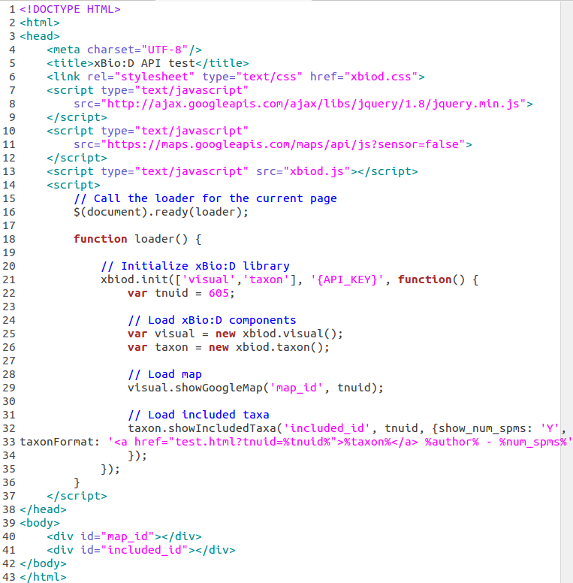Difference between revisions of "XBio:D Javascript Library Reference"
(→Examples) |
(→Examples) |
||
| Line 14: | Line 14: | ||
[http://osuc.biosci.ohio-state.edu/JSLib/xbiod_lib/test.html View simple example here] | [http://osuc.biosci.ohio-state.edu/JSLib/xbiod_lib/test.html View simple example here] | ||
| + | |||
| + | There are a few things to note about this example: | ||
| + | * The '''<!DOCTYPE html>''' tag is necessary for HTML 5 applications | ||
| + | * The Map API Javascript is included with a '''<script>''' tag | ||
| + | * In the '''<body>''' there are two '''<div>''' elements which create areas to hold the widgets. The first is called ''map_id'' and the second is ''included_id''. | ||
| + | * Two objects where created to access the xBio:D components called ''visual'' and ''taxon''. These | ||
Revision as of 16:08, 30 July 2014
Introduction
The XBio:D Javascript library offers the functionality to create rich, dynamic, and interactive features for use with the OJ_Break API. The OJ_Break API provides procedures to retrieve data within the xBio:D database, and the xBio:D JS library is how that data gets presented. Users planning on working with the xBio:D JS library should be familiar with Javascript programming and object-oriented programming.
API Access
All functionality in the xBio:D JS library depends on access of data from the OJ_Break API. See OJ_Break API Access for an overview of the API and how to obtain an API access key.
Examples
An easy way to become familiar with the xBio:D JS library is to see a simple example involving two web applications. The first is a Google Maps widget which takes data from the OJ_Break method getLocalities for a specified tnuid and displays the data onto an interactive map. Read more about the Google Maps Javascript API here. The second application used in the example is a listing of included taxa for a specified tnuid by using the OJ_Break method getIncludedTaxa.
There are a few things to note about this example:
- The <!DOCTYPE html> tag is necessary for HTML 5 applications
- The Map API Javascript is included with a <script> tag
- In the <body> there are two elements which create areas to hold the widgets. The first is called map_id and the second is included_id.
- Two objects where created to access the xBio:D components called visual and taxon. These
